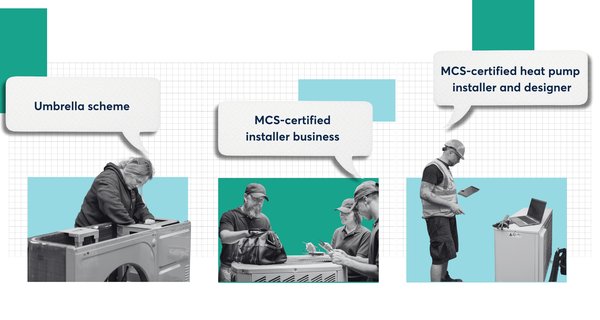The simplicity of the BUS scheme is building confidence in the heat pump market.
- However, the scheme is very limited in terms of the technologies incentivised.
- The structure of the subsidy may limit business models, such as those that had begun to emerge under RHI. The current BUS is only applicable when the household owns the heat pump outright after installation.
What we’ve heard
One of the most repeated comments we’ve heard from stakeholders regarding BUS is the value in its simplicity – how the limitation in eligible technologies enables a clear signal to the most relevant low-carbon heating solutions for most homes and how efficient the delivery structure is when considering the balance of administration and user requirements.
“The brilliant thing about BUS at the moment is its simplicity… uniform discount applied by the installer at point of sale, extremely easy to redeem. Adding new technologies would risk losing this simplicity for limited benefit as ASHP are the best low carbon heat solution for 80% of homes in the UK.”
Although this limitation to three, nearly self-selecting technologies is indeed an efficient format, statements from installers indicate that increased adoption could be gained by including, at minimum, solar PV as an option to be packaged – but likely also electrical or thermal storage, similar to HES. Also, nearly all installers and retrofit coordinators called for the inclusion of draught-proofing and ventilation into central grant schemes, especially considering longer heating schedules with heat pumps – to ensure quality outcomes and energy efficiency.
“Every customer has asked about solar PV. Keen to try and offset the price of them. A package with PV would likely increase adoption.”
“A whole package – PV, battery, heat pump, insulation – should be supported to… minimise the grid burden and dependency.”
“Also BUS should cover retrofit MVHR to facilitate greater air-tightness and thus massive efficiency gains, ideally BUS should cover PV installations if in conjunction with HP or MVHR,”
In December 2023, the Government published a Summary of Responses to the Call for Evidence, in which they confirmed the expansion of VAT relief to battery storage systems either retrofitted onto existing solar PV installations or standalone connected to the grid. This signals a recognition of the value of flexibility – either long-term or within a time-limited transition period – and may hint at the opportunity to include additional technologies within BUS.
Several stakeholders stated an interest in seeing higher subsidy amounts for ground-source heat pumps (GSHPs) and shared ground loops (SGLs), often indicating £9-10K as an appropriate level rather than returning to the higher levels under RHI. This group included a few general installers and homeowners but mostly came from special interest groups (suppliers of GSHPs and industry bodies). The lower uptake of GSHPs was stated as primarily driven by the low subsidy level relative to costs, rather than any market or preference changes. This is similar to views from the UK Parliament inquiry.
“There has been a marked reduction in GSHPs deployed… under the domestic RHI, 15,297 GSHP installations were accredited… an average of 1,700 a year…13% of all installations. This contrasts sharply with the BUS… 708 GSHP & SGL installations… in the first 16 months (annual average of 531), representing 3% of installations… RHI would have provided £12,780 for a GSHP installation and £6,360 for an ASHP one.”
Most respondents who were aware of shared ground loops also agreed that eligibility restrictions from the 45kW capacity limit for the loop should be addressed – either increasing the capacity limit or adjusting the subsidy structure. A few mentioned shared ground loops and district heating as a way to accelerate the adoption of low-carbon heat – as it may help to transition whole communities at one time.
“Ground [loops], multiple homes at once… the way forward… district heating to communities, whole towns fitting one plant with government subsidy supporting… [value] to households would mean no other choice worth considering… but not going to work everywhere.”
The most common alternative low-carbon heat source that is subsidised in other European countries is air-to-air heat pumps. The level of grants available for air-to-air heat pumps is typically reduced in comparison to that for air-to-water heat pumps. For example, Ireland provides €3,500 for an air-to-air heat pump compared to €6,500 for an air-to-water or ground-to-water heat pump (EHPA, 2023).
Some installer statements indicated that, compared to other countries, the UK may need more support for air-to-air, as cooling is not an effective driver at this time. However, there is likely still an opportunity to highlight any expected growth of cooling demand towards 2050 more effectively.
“I don’t see cooling as a driver towards heat pump adoption. You have to rip the house apart to put it in. They should just get air con if they want cooling.”
“The grant doesn't apply to A2A, which may be important, especially as we look towards a greater cooling regime. It’s especially viable if you haven’t got an existing wet distribution system.“
“Grant needs to be better… about £10K… and need to bring in air conditioning [air-to-air] and ventilation as well… too much to upgrade the heating systems for some homes. And should allow just heating, leaving hot water to the homeowner's choice… costs could then come down.”
When considering all stakeholder input, there is disagreement as to whether air-to-air heat pumps should receive any funding and, if so, whether to be included in BUS or a separate scheme. Most suggesting support for air-to-air stated that it’d be unnecessary in a ‘healthier’ market but that currently a strong signal is required against the air-to-water push. A few commented on the greater potential for air-to-air in specific property types.
“Air-to-air heat pumps don't need subsidising in many cases, but current BUS subsidy… distracts from healthier growth… providing a nominal subsidy for them would signal that they should be considered in more cases.”
Two respondents to our initial survey expressed a concern that although air-source heat pumps should indeed receive the strongest signalling, the lack of any level of funded incentives surrounding BUS (or ECO+) for flexible electric or thermal storage systems (Tepeo, Sunamp) is seen as preventing their consideration by most households. One installer thought we should provide additional choices to mitigate the number of homes installing solid fuel (biomass) boilers, noting a package of minimum insulation, MVHR, and advanced electric storage heating should be an option.
“... lack of diversity in supported solutions… creates the impression for consumers that hydronic heat pumps are the only technology that can decarbonise their heating… currently a barrier for ensuring appropriate low-carbon heating is achievable for every home… subsidies should cover any heating system under the Smart Heating Mandate that DESNZ is developing.”
We also heard that some limitations may be impacting innovation in the sector. Under the current BUS scheme, the homeowner must own any hardware installed. Whereas previous schemes such as the Green Homes Grant enabled lease-purchase ownership models to start to be implemented.
“Today's Boiler Upgrade Scheme requires the end user to own the product to qualify for the grant. In the rest of Europe, this is not the case. In Germany for example, various types of models exist that all qualify for subsidies – leasing or monthly subscriptions for example where the company who installs and leases the product applies and gets the subsidy in its own name. These alternative ownership models are very common to make high-cost products available for a larger population.”
Similar statements were made for hybrid and bivalent heat pumps. Bivalent and hybrid systems are heating systems that pair a heat pump with a fossil fuel boiler. There were suggestions that this technology may help to reduce emissions quicker while also attracting a level of grant that is less than that of the current BUS.
“Yes, hybrid systems should attract the same proportion of funding relative to the CHMM credit of 0.5. Therefore 0.5 of £7500 = £3750. (On the current BUS scheme)… it is time-consuming and requires a number of prerequisites to be undertaken. This will not be accepted in a boiler breakdown situation where heat and water need restoring ASAP. Hence the attraction of hybrids.”
There were some concerns that any subsidy of hybrid or bivalent systems would need to be carefully considered to reduce the risk of potential gaming of a subsidy system, and a single heating system being subsidised multiple times, above and beyond the rate of a direct switch from fossil fuel heating directly to low carbon heat. In the workshop ran as part of this project there was general agreement on “if hybrids are to be included then a grant should be proportional to decarbonisation achieved”
Considering how BUS already has an eligibility constraint for biomass boilers, a similar type of division for hybrid systems may not result in losing the essential simplicity as long as a centralised lookup is readily available.
What barriers do we need to overcome?
For installers/HP suppliers
- Administrative or paperwork burdens on installers.
- The lack of flexibility in technology and system design can limit engineers' ability to decarbonise certain homes.
- For example, the 45kW limit on shared ground loop capacity is a constraint within BUS compared to the number of homes a typical networked heat pump project may require to be economical.
- The current BUS structure can be inflexible when pairing technologies.
- The current BUS scheme requires the household to own the heat source, this may be limiting the payment options that installers and heating manufacturers can offer.
For households
- The simplicity of the BUS grant becomes less significant for homeowners once any household begins considering additional works or requires additional funding for a heat pump installation.
- Lack of signalling of the importance of ventilation and draught-proofing.
For policymakers & scheme administrators
- Towards 2030, air-source heat pumps may start competing against shared ground loop heat networks in their target market. Alongside this, heat network zoning may start to add confusion unless households have a single point of access to rely on for eligibility for all grants.
- There was a highlighted gap in affordability predominantly low-income and medium-income households that fall outside of ECO schemes.
- If hybrid/bivalent schemes are to be considered, uncertainty around energy costs (around reforms and universal access to relevant tariff types or flex-enabling technologies) increases the variance in carbon reduction which policymakers might expect from hybrid or bivalent systems.
Concepts/recommendations
What if...
- A low-carbon heating system was able to be purchased using a combination of subsidy and hire purchase agreement or similar?
- Overheating days were considered to the same extent as heating days when considering a heat source and accessing subsidies? Would this alter the appeal and selection of technology?
- The subsidy was based on the system carbon reduction, could this be a way to fairly incentivise a broader range of technology?






